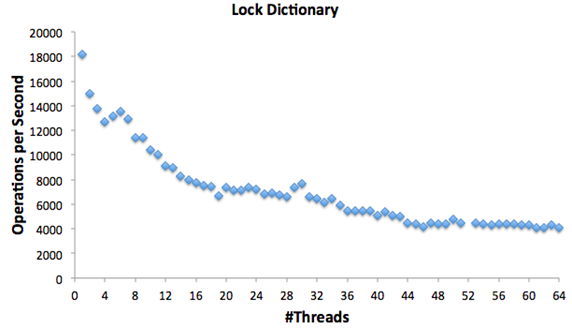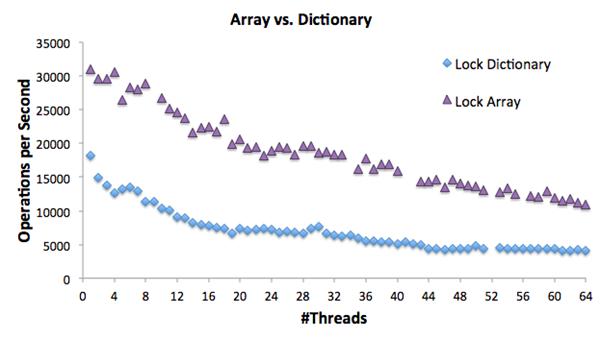Synchronisation in .NET– Part 1: lock(), Dictionaries and Arrays
As part of our tuning efforts at Livedrive, I ran into a deceptively simple problem that beautifully illustrates some of the scale principles I have been teaching to the SQL Server community for years.
In this series of blog entries, I will use what appears to be a simple .NET class to explore how modern CPU
architectures handle high speed synchronisation. In the first part of the series, I set the stage and explore the .NET
lock() method of coordinating data.
The Problem: Write a Class that tracks duration of Operations
The problem we are trying to tackle is add instrumentation to a .NET application server. We would like to get aggregated statistics about how long business operations inside the server takes and how many times each business operation gets executed.
The desired output is:
| Operation | Count | TotalTimeMs | MaxTimeMs | MinTimeMs |
|---|---|---|---|---|
| Foo | 42 | 104 | 20 | 1 |
| Bar | 13 | 1303 | 500 | 75 |
With a class that tracks this information, we can query the application server while it is running to understand how
long common operations take and where to tune first. Of course, we can get to this level of detail by plugging into
Event Tracing for Windows (ETW) and analysing using tools like
xperf and Windows Performance Analyser (or perf if you are on Linux).
But for our scenario, we would prefer to explicitly measure code paths that represent full business operations instead
of doing generic code profiling. We would also like this data gathering to be running non stop.
(Users of SQL Server may be familiar with sys.dm_os_wait_stats and it should be obvious why I would want something
like this done for a generic application server).
Apart from the functional goal, we have the following performance requirements:
- The class should not introduce a new bottleneck in the code it measures
- It should add barely measurable CPU overhead, ideally only a few %
- The same operation should be log-able from several code paths, this should not introduce any contention between these code paths
Initial Design
In the following, I will sketch the high level design required. There are several ways to implement this design, but to compare implementations, let us first agree on the common interface of the class we need to build.
From the problem description, it should be obvious that the implementation needs to contain a data structure like this:
private struct OperationData
{
public long TotalTimeMs;
public long Count;
public long MaxTimeMs;
public long MinTimeMs;
}And we can also specify the desired interface that must be implemented:
public interface IAggregateStatistics
{
/// <summary>
/// Clears the data in the class
/// </summary>
void Clear();
/// <summary>
/// Add or update a measurement in the instance of the class
/// </summary>
/// <param name="operation">The operation to update statistics for</param>
/// <param name="timeMs">The time measured by the caller</param>
void Add(int operation, int timeMs);
}The Add() method takes an integer representing the operation to log (example: Foo = 0, Bar = 1). We could implement
this parameter as an enum or a string too, but let’s keep the example simple and just assume the caller passes us an
integer. To further simplify, we can also assume that those integers fall into a fixed range so we can know the maximum
number of rows in the output at compile time.
Obviously, there are other ways to implement this class. For example, the time measurement itself could be part of the
class. However, for the purpose of this blog, I would like you to focus on the problem of keeping the OperationData
class/struct up to date at high concurrency. For the rest of this blog series, the focus will be on the Add() method with hints on how to implement Clear() where this is (pardon the pun) unclear.
Implementation: ConcurrentDictionary and lock()
Let us try the simple and straightforward way to implement this class. Here is the code:
private ConcurrentDictionary<int, OperationData> _opsData
= new ConcurrentDictionary<int, OperationData>();
public void Add(int operation, int timeMs)
{
OperationData s;
if (!_opsData.TryGetValue(operation, out s))
{
s = _opsData.GetOrAdd(operation, new OperationData());
}
/* Lock up the entry */
lock (s)
{
s.TotalTimeMs += timeMs;
s.Count++;
s.MaxTimeMs = Math.Max(timeMs, s.MaxTimeMs);
s.MinTimeMs = Math.Min(timeMs, s.MinTimeMs);
}
}This takes a granular lock on the dictionary entry for the statistic we are trying to update. This is safe because
Clear() of a ConcurrentDictionary creates a new, empty dictionary. What this means is that even if an Add()
operation is racing with a Clear() operation, our change of s (inside the lock) will just be lost and garbage
collected.
To benchmark the different implementation we will try in this blog series, I have created a test harness that
initialises an implementation of IAggregateStatistics, starts multiple threads and logs 4 different operations
(randomly) at high speed. The exact details on how to implement such a high speed test harness is a subject for a
completely different blog entry.
Benchmark: lock() and ConcurrentDictionary
To compare implementations, we will use a test harness that logs 4 different operations (creating a moderate amount of
contention on big boxes) and measures the number of calls to Add() that are done per second
The results are not encouraging on the 4 socket, 8 cores (16 in HT) machine:

The scale of the class breaks already at 2 threads. I would expect that as we add more threads and more CPU power, more operations can be logged every second. At a maximum of just over 18K operations/sec – this implementation will not scale to our requirements. Recall that I have previously proven that a single SQL server is well capable of 1M operations/sec.
It’s worth noting that at least two locks are being taken in this implementation:
- A lock on the dictionary itself (during
TryGetValue) - A lock on the entry while it is being updated
Implementation Array and lock()
While .NET has some great concurrent data structures, they are meant to be generic and widely applicable, not optimised for specific use cases. When programming for high scale, it is often necessary to create your own, highly optimised data structures.
For our purpose, an array really is good enough, we don’t need ConcurrentDictionary and the locking overhead that
comes with it.
Let us now attempt this implementation which uses an array instead:
private StatData[] _opsData = new OperationData[OPSLIST_LENGTH];
public void Add(int operation, int timeMs)
{
OperationData s = _opsData[operation];
lock (s)
{
s.TimeMs += timeMs;
s.Count++;
s.MaxTimeMs = Math.Max(timeMs, s.MaxTimeMs);
s.MinTimeMs = Math.Min(timeMs, s.MinTimeMs);
}
}
}Recall that we know the maximum number of operations we want to time (4 for the purposes of our test case), which allows us to pre-size the _opsData array. With this implementation, a trivial constructor is required too in order to new the objects in the array.
Clear() can be implemented by traversing the array and locking each element in turn. Alternatively, a new array can be
allocated and swapped out with the old one.
I leave it to the reader to come up with an implementation that works even if the number of operations is not known in advance. It's not that hard.
Benchmark: Array and lock()
Running the same test used for the Dictionary, we get this result:

The array implementation performs about twice as fast as the dictionary. For both implementations, the scale goes negative under even moderate concurrency, though the array seems to hold up a little better for the first 8 cores.
Pinning
While running benchmarks, Henk noticed that the cores used by the harness were not always the same ones. While the number of busy cores DID match the thread count, the cores that were busy would “wander” around depending on the state of the test and the .NET scheduler.
To correct for this, I modified the test harness to pin each new thread to the next unused core, gradually added more and more pinned threads (starting from logical CPU 0 and up to logical CPU 63).
Benchmark: Pinning to Cores
Interestingly, the test results with the harness changes now become:

The array implementation is still twice as fast as the dictionary at low concurrency, but it quickly falls into the same low performance of the dictionary. Also notice that as we add a second core to the array implementation (the hyper thread partner of the first one) we actually get a little bit of extra scale. Interestingly, this matches the theory of the performance measurement that showed 70% of a single CPU core is spend in acquiring/releasing the lock. In other words: there is a slight amount of scale (up to ~30%) to be found by going from one to two threads, but only if they share the same CPU caches (more about this in the next entry).
Summary
In the implementations used, it is obvious that even a single core can saturate the maximum throughput of the data structure.
Behind the scenes, the lock() statement is an implementation of the Windows Monitor object
(source: http://msdn.microsoft.com/en-us/library/ms228964(v=vs.110).aspx). We might hypothesise that the CPU cost of
entering an exiting the monitor dominates the workload. We can confirm this hypothesis with a quick Visual Studio code
profile of the code running on one thread:

Over 70% of one CPU is spent to enter/exit the monitor. Since only one core can be in the critical section at any time, this limits the throughput to one or two cores worth of calling Add. While we are logging 4 different operations, it appears that the cost of coordinating between threads drowns out any benefits of concurrency. In other words: The work required inside the lock is cheaper than the lock itself and hence the data structure does not benefit from parallelism.
With the array implementation, the number of locks required is cut in half, which then halves the number of
Enter/Exit calls. This expectedly doubles throughput.
The implementation chosen so far does not meet the requirements! If we were to log operations using this implementation, the logging itself would introduce a bottleneck to the logged code.
Read the rest of this series:



 5 min
5 min
 12/25/2013
12/25/2013
 Listen
Listen



